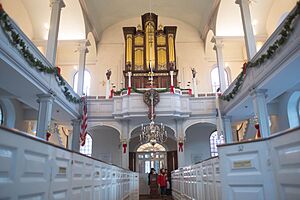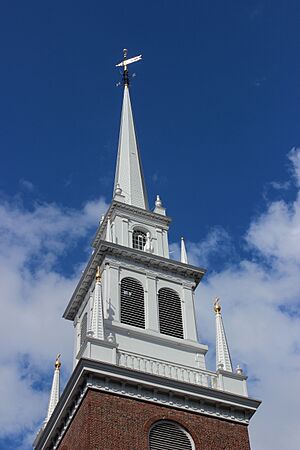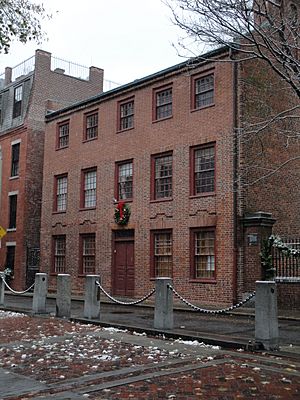Old North Church facts for kids
Quick facts for kids Old North Church |
|
|---|---|
| Christ Church in the City of Boston | |
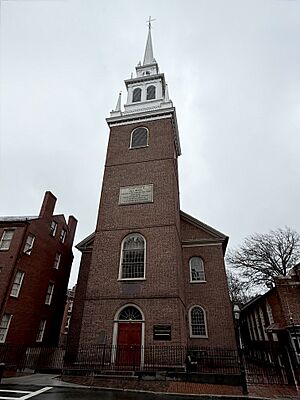
The building in 2025
|
|
| 42°21′59″N 71°3′16″W / 42.36639°N 71.05444°W | |
| Location | Boston, Massachusetts, U.S. |
| Country | United States |
| Denomination | Episcopal |
| Website | Old North Church |
| Architecture | |
| Architect(s) | William Price |
| Architectural type | Georgian |
| Administration | |
| Diocese | Diocese of Massachusetts |
The Old North Church (officially Christ Church in the City of Boston) is an Episcopal church in the North End neighborhood of Boston, Massachusetts. Built in 1723, it is the oldest church building still standing in Boston. It is also a National Historic Landmark, which means it is a very important historical place.
Old North Church is famous for its role in Paul Revere's midnight ride on April 18, 1775. On that night, the church's sexton, Robert Newman, hung two lanterns in the church's steeple. This signal warned Revere and other riders about British military movements. This happened just before the battles of Lexington and Concord, which were the first battles of the American Revolutionary War.
Contents
History of the Old North Church
Construction of the Old North Church began in April 1723. Nine months later, on December 29, the church was ready enough for its first worship service. Only some inside finishing work was left to do. The church's design was inspired by the work of English architect Christopher Wren. He helped rebuild London after the Great Fire. Timothy Cutler was the first leader, called the rector, of the church.
Early Years and Trade Connections
Boston was an important port city in the 17th and 18th centuries. The Old North Church, first called Christ Church in the City of Boston, was established in 1723. It was Boston's second Anglican Church. It became a social center for younger merchants and ship captains in Boston. They used the church to build trust and connections for their trade across the Atlantic Ocean.
Some merchants connected to the church were involved in trade that included goods like cacao and Logwood. These goods were often produced by enslaved African and Indigenous people. For example, a group of traders called the "Gentlemen of the Bay of Honduras" donated logwood to the church in 1727. This donation helped pay for the church's first steeple. A special pew, called "The Bay Pew," is still in the church today. It shows how some pews might have looked in the past.
The American Revolution and Paul Revere
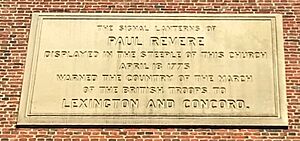
In April 1775, Paul Revere asked three patriots in Boston to hang two lanterns in the church steeple. These men were the church sexton Robert Newman and Captain John Pulling Jr. Thomas Bernard also helped by watching for British troops outside. The lanterns were a signal to patriots in Charlestown, across the Charles River. They warned them about the British Army's movements.
The lanterns were only lit for a short time, less than a minute. This was to avoid being seen by British troops in Boston. But it was long enough for the message to reach Charlestown. The militia waiting there knew to look for the signal.
The meaning of the two lanterns is famous: "One if by land, and two if by sea." This line comes from Henry Wadsworth Longfellow's 1860 poem "Paul Revere's Ride". One lantern meant the British Army would march by land. Two lanterns meant they were taking boats across the Charles River (the "sea" route). The British took the "sea" route, so two lanterns were hung. After seeing the signal, the Charlestown Patriots sent a rider to Lexington.
The warning spread quickly to many towns. Revere and William Dawes rode horses, and other people rang church bells, beat drums, and fired warning guns. The original lanterns are now in different places. One is believed to be with a private collector, and another is on display at the Concord Museum.
After the Revolution
Between 1806 and 1912, the church changed its seating. The original box pews were replaced with "slip pews" to fit more people. In 1912, the pews were restored to look more like the original box pews. Today, seating is open to everyone, first-come, first-served.
In the 19th century, a Sunday school for children, called the Salem Street Academy, was next to the church. The Old North Church helped run this school. It provided childcare for parents and a place for children to attend church services, even if their families couldn't afford fancy clothes for regular services.
20th Century Changes
1912 Restoration
In 1912, the church was rebuilt to look more like it did when it was first built. Architects R. Clipson Sturgis and Henry C. Ross led the work. They replaced old floor timbers and stairs. The box pews were rebuilt, and the raised pulpit was restored. The church reopened on December 29, 1912, which was its 189th anniversary. Theodore Roosevelt, a former U.S. President, attended the reopening.
U.S. Bicentennial Celebration
On April 18, 1975, U.S. President Gerald Ford visited Old North Church. In his speech, he talked about freedom and hope for the future. After his speech, two lanterns were lit by descendants of Robert Newman, the sexton who lit the original lanterns in 1775. President Ford then lit a third lantern, which still hangs in a church window today.
On July 11, 1976, Queen Elizabeth II visited Boston as part of the United States Bicentennial celebrations. She attended a service at the Old North Church with Prince Philip. The Queen was given a replica of a silver cup made by Paul Revere. She also saw the famous statue of Paul Revere near the church.
Old North Church Today
Today, Old North Church is one of the 16 stops on the Freedom Trail, a famous walking tour in Boston. It is still an active church with Sunday morning services. The current vicar is the Rev. Dr. Matthew Cadwell.
Church Structure
Sanctuary and Upper Gallery
The Old North Church's main worship area, the sanctuary, opened in December 1723. In the past, people bought "box pews" in the sanctuary. Owning a pew meant they had a say in church matters. The church also had pews for visitors.
The beautiful brass chandeliers were added in 1723. The organ was installed in 1759. The four angels around the organ were donated in 1746 by Captain Thomas Gruchy. He captured them from a French ship during a war.
Upstairs, in the North and South Galleries, there were pews for people who couldn't afford the main pews. This included people with less money, children under 12, and Black and Indigenous church members. Enslaved people were expected to attend church with their enslavers but sat in the gallery. It was often cold in winter and hot in summer in the gallery, and sermons were hard to hear. Despite these challenges, many Black and Indigenous people attended for various reasons, including spiritual ones or because they were required to.
Steeples
The Old North Church's steeple is famous for its role in Paul Revere's lantern signal in 1775. It has become a symbol of liberty in the U.S.
The first steeple was finished in 1740. It was designed by William Price. A golden weathervane made by Shem Drowne was placed on top. This made Old North Church the tallest building in Boston. Paul Revere, who was young at the time, sometimes rang the bells in this steeple.
The first steeple was destroyed by a hurricane in 1804. A new steeple, designed by Charles Bulfinch, was built in 1806. However, this second steeple was also knocked down by Hurricane Carol on August 31, 1954.
After that, people raised money across the country to build a third steeple. It was finished in October 1955. This new steeple looks like the first original one and has steel to make it stronger. Drowne's original weathervane, which was found after the 1954 hurricane, was put back on top. This is the steeple you see today. The church is now about 174 feet tall.
Bells
The Old North Church has eight bells that were made in England in 1744 and hung in 1745. One bell has a special message: "We are the first ring of bells cast for the British Empire in North America, A.R. 1744." The bells were repaired in 1894 and 1975. They are still cared for and rung regularly by the Massachusetts Institute of Technology Guild of Bellringers.
Crypt
The church has a crypt (an underground burial place) in its basement. About 1,100 bodies are buried in 37 tombs there. The crypt was used from 1732 to 1860.
Famous people buried in the crypt include the first rector, Rev. Timothy Cutler, and his wife. British Marine Major John Pitcairn, who died from injuries in the Battle of Bunker Hill, is also buried there with other soldiers. Captain Samuel Nicholson of the USS Constitution is also in the crypt. Visitors can take a tour to see the crypt and the bell-ringing chamber.
Clough House
Behind the Old North Church, on Unity Street, is the Clough House. This historic building was built in 1715 by Ebenezer Clough, a master brick mason. He also helped build the Old North Church in 1723. Today, the Clough House is part of the Old North Historic Site.
Old North Illuminated
In 1991, the Old North Foundation was created. It is now called Old North Illuminated. This group is separate from the church and helps manage the historic site. They run educational programs and work to preserve the church. As of 2025, Angela Johnson is the chairman of the board and Nikki Stewart is the executive director.
Old North Church Gift Shop
The building that is now the Old North Church gift shop was built in 1918. It was originally a chapel for Italian immigrants in the North End. The Old North Church helped these newcomers. Later, as interest in the Old North Church as a historic site grew, the building was bought and turned into a museum and gift shop. Today, it is still the gift shop. Many of its original architectural details, like the cross on the roof and stone lions, can still be seen. The gift shop building is also on the National Register of Historic Places.
Rectors of Old North Church
The first rector of Old North Church was Reverend Dr. Timothy Cutler. He was born in Massachusetts in 1684 and studied at Harvard College. He became the leader of Yale College before coming to Boston. Cutler traveled to England to become an Anglican priest. He returned to Boston in 1723 and led his first service at Old North Church on December 29, 1723. He served the church until he passed away in 1765 and is buried in the crypt under the altar.
Reverend Mather Byles Jr. served as rector from 1768 to April 1775. He was a loyalist, meaning he supported the British King during the American Revolution. On April 18, 1775, the same day the lanterns were hung in the steeple, Byles left his position. He and his family later moved to New Brunswick.
Stephen Lewis became the rector in August 1778. He had been a chaplain for British troops but decided to support Massachusetts. He helped reopen the Christ Church (Old North) after it had been closed since 1775. Lewis served until 1784.
Diverse Worshippers
Recent studies have helped us learn more about the Black and Indigenous people who worshipped at Old North Church. For a long time, most of what was known was about the wealthy white members.
The Humphries family, a free Black couple named John and Elizabeth, are an example. They baptized eight of their children at Old North Church between 1748 and 1751. After John passed away, three of their children were indentured, meaning they worked for someone for a set period.
Church records also show the baptism of an Indigenous woman named Jerusha Will in 1743. Her story, though brief, helps us understand the diverse community connected to the church.
In 1765, an "Elizabeth Humphries" married an enslaved man named Robert Hunter. This marriage was important because Elizabeth was a free woman. In the colonies, a child's status depended on their mother's. By marrying a free woman, Robert and Elizabeth ensured their children would be born free.
Slavery in Colonial Boston
Slavery existed in the New England colonies as early as the 1630s. During wars, Indigenous prisoners were sometimes sold to the Caribbean in exchange for enslaved Africans. These enslaved people were then brought to places like Boston. In the 18th century, enslaved Black people made up about 10-15% of Boston's population. Many other Black and Indigenous people, and even some poor white Europeans, also lived in various forms of "unfreedom."
Church records show the baptisms, marriages, and funerals of both free and enslaved Black and Indigenous people. The Old North Church's first rector, Timothy Cutler, enslaved a woman named Ann. He was also a missionary for a group that aimed to convert enslaved people.
The Other "Old North"
Before the Old North Church (Christ Church, Boston) was built, there was another church in Boston also called the "Old North" (Meetinghouse). This was a Congregationalist church located in North Square. It was once led by the Rev. Cotton Mather, who is known for his involvement in the Salem witch trials.
Archives
The Old North Church's historical records are kept at the Massachusetts Historical Society. Researchers can view them by making an appointment.
See also
 In Spanish: Old North Church para niños
In Spanish: Old North Church para niños
- Old North Church, Hollywood, a replica of the Boston church
- List of National Historic Landmarks in Boston
- National Register of Historic Places listings in northern Boston


